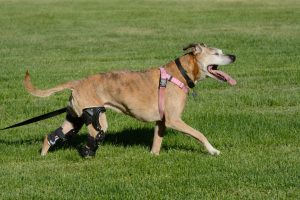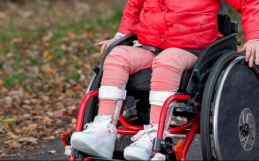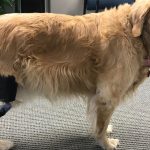Why Is My Dog Limping ?
Noticing that your dog has developed a sudden limp is alarming, and as a much-loved member of your family, you’ll want to quickly find out what’s causing your pet’s discomfort.
In this blog, we’ll answer some questions around common causes of limping in dogs, and what you can do to help your pet recover.
Lameness in Dogs: How to Tell if It’s Age or Injury Related
Certain breeds of dogs are more prone to joint-related issues as they get older – especially larger breeds. For example, the ever-popular Labrador is well-known to suffer joint issues that can surface from a relatively young age.
For a senior dog, lameness often indicates age-related issues to do with wear and tear in soft tissue, the thigh bone, or joints.
For younger dogs, overdoing it outdoors while running around and playing with other dogs is a more likely scenario that leads to limping.
Either way, it’s important to seek out veterinary care if your dog is in discomfort and is only using three legs to walk.
 Common Signs Of Knee Injury
Common Signs Of Knee Injury
One of the most common causes of lameness in dogs – especially older dogs – is knee injury in the hind legs.
The good news is that early detection and treatment of knee issues in dogs decreases the likelihood of needing knee surgery down the line.
Although your beloved pet is unable to tell you directly that something’s wrong, there are a few tell-tale signs to look out for that indicate your dog is struggling.
The most obvious indicator is impaired movement, such as difficulty jumping onto furniture or struggling to get up and down the stairs.
You may even hear a clicking noise in the knee or observe abnormal sitting behaviour in your dog.
If you notice any of these – or any inflammation or swelling around the knee area – be sure to seek out veterinary care as quickly as possible so that your vet can advise on a treatment plan for your dog.
What Is Lameness?
Lameness is when your dog limps or favours one leg over another.
It is a natural response to discomfort and the body’s attempt to protect and promote healing in the affected area. Dogs will favour one leg when experiencing discomfort in the opposite limb — for example, they may limp on three legs while their recovery leg rests and soothes the muscles and tendons.
You should always consult with your vet first for a referral and a specific diagnosis we can treat. While there are many instances when your vet will recommend knee surgery for hind leg issues, depending on the age and overall health of your dog. For aging dogs that are at possible risk from an operation, a brace that aids in stabilizing the joint, and maintaining a healthy and active lifestyle, can be an excellent alternative to surgery for your pet.
If your dog does need surgery, a postoperative brace may still be suitable as an extra measure to aid recovery.
 What Is the Right Brace for My Dog?
What Is the Right Brace for My Dog?
If your vet recommends a knee brace as part of your dog’s treatment plan it’s important to ensure you choose one that actively stabilizes the joint and supports your pet as it recovers.
At Applied Biomechanics, our braces are custom-made for a precise fit and are designed to provide your dog with the stability and support it needs, while allowing controlled freedom of movement to aid in recovery. Contact us today.

 Common Signs Of Knee Injury
Common Signs Of Knee Injury What Is the Right Brace for My Dog?
What Is the Right Brace for My Dog?




